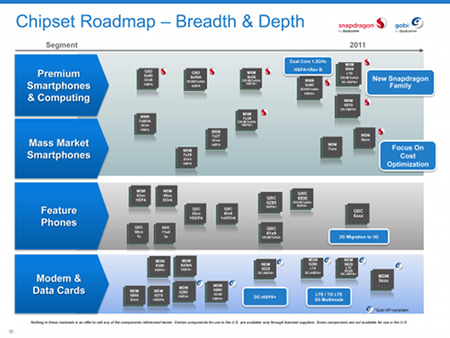28nm Snapdragon will add LTE support, faster graphics
Nov 18, 2010 — by LinuxDevices Staff — from the LinuxDevices Archive — 2 viewsQualcomm has shown off a new version of its Snapdragon chipset that will let handsets work with LTE (Long Term Evolution) networks as well as current 3G networks. Set to sample in 2011, the MSM8960 will also integrate Wi-Fi, GPS, Bluetooth, and an FM receiver, according to a variety of reports.
The only reference we could find to the MSM8960 on Qualcomm's website is the obviously dated slide reproduced below. According to a variety of sources, however, the chipmaker detailed its new Snapdragon offering at a meeting held for analysts yesterday in New York.

This slide suggests the MSM8960 was originally slated for a 2010 rollout, perhaps in a 45nm version
(Click to enlarge)
It's said the MSM8960 will be the company's first mobile processor to move to a 28nm design. A new microarchitecture will allow the device to deliver approximately five times the performance of the original Snapdragon chip (see later in this story for background), while using 75 percent less power, Qualcomm adds.

Qualcomm's MSM8960
(Click to enlarge)
In his presentation, Qualcomm Executive Vice President Steve Mollenkopf reviewed the success of the company's current Snapdragon offerings and then made the claims cited above. Another slide (below) suggested that the MSM8960 will include dual cores clocked at 1.2GHz, much like the MSM8260 and MSM8660 that were announced in June.

Qualcomm's MSM and QSD roadmap
(Click to enlarge)
Where the MSM8260 targets only HSPA+ networks and the MSM8660 supports both HSPA+ and CDMA2000 1xEV-DO Rev. B, however, the MSM8960 will support both of these plus LTE, making it the "world's first multi-mode 3G/4G integrated chipset, in Qualcomm's words. The device will also include Wi-Fi, a GPS receiver, Bluetooth, and FM, the company adds.
In an apparent comparison to the original Snapdragon, Mollenkopf said the MSM8960 will offer "four times" the graphics performance. It's said the chip's "Adreno 3xx" GPU (graphics processing unit) will, like those on the MSM8260 and MSM8660, provide OpenGL-ES and OpenCL v1.1 compatibility as well as 1080p video encode/decode.
Background
Qualcomm's MSM8960 chipset represents the latest version of the company's Snapdragon, which has dominated the world of high-end smartphones and is employed in every Windows Phone 7 device.
The original 1GHz QSD8250/8650 Snapdragon chipsets debuted in Nov. 2007, featuring a Scorpion core that — like the ARM Cortex-A8 — is based on the ARMv7 instruction set and offers similar superscalar technology. (In fact, many observers refer to it flatly as a member of the Cortex-A8 family.)
The QSD8x50 was followed in 2009 by a 1.3GHz QSD8650A, which added 2D/3D graphics accelerators, and was touted for its up to 30 percent lower power consumption. Qualcomm later announced a 1GHz, mid-range MSM7x30 variant of the Snapdragon design said to be capable of capable of playing 720p video.
In its June announcement, Qualcomm called the MSM8x60 chipsets the first dual-core versions of the Snapdragon. However, last year the company began sampling a somewhat similar QSD8672 that combined two 45nm-fabricated 1.5GHz Scorpion cores.
The QSD8672 and MSM8x60 were both touted by Qualcomm as representing the third generation of Snapdragon technology. With its LTE support and 28nm fabrication, the newly announced MSM8960 apparently moves ahead still further.
Further information
According to Qualcomm, the MSM8960 will begin sampling during 2011. A copy of Steve Mollenkopf's presentation may be found on the Anandtech website, here.
This article was originally published on LinuxDevices.com and has been donated to the open source community by QuinStreet Inc. Please visit LinuxToday.com for up-to-date news and articles about Linux and open source.